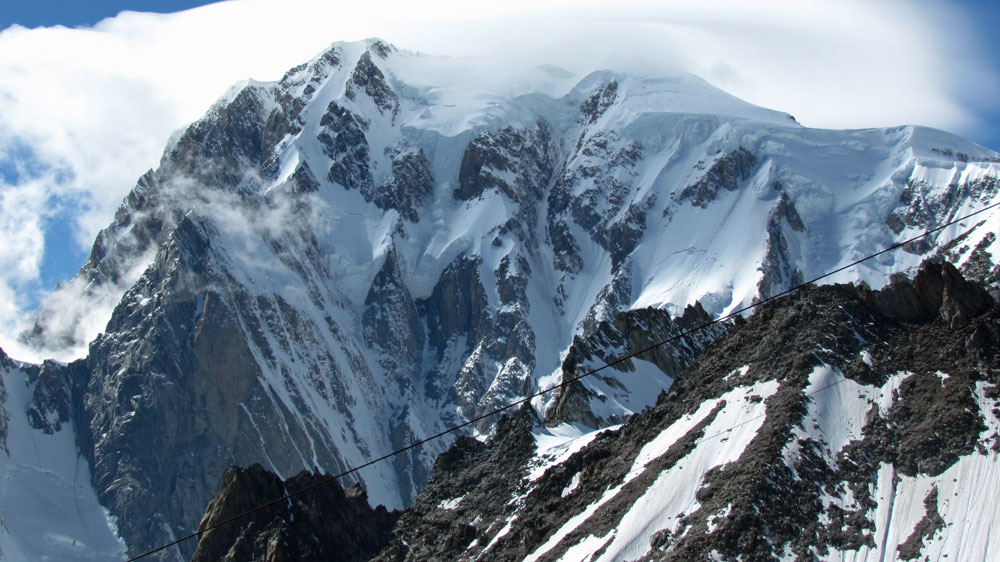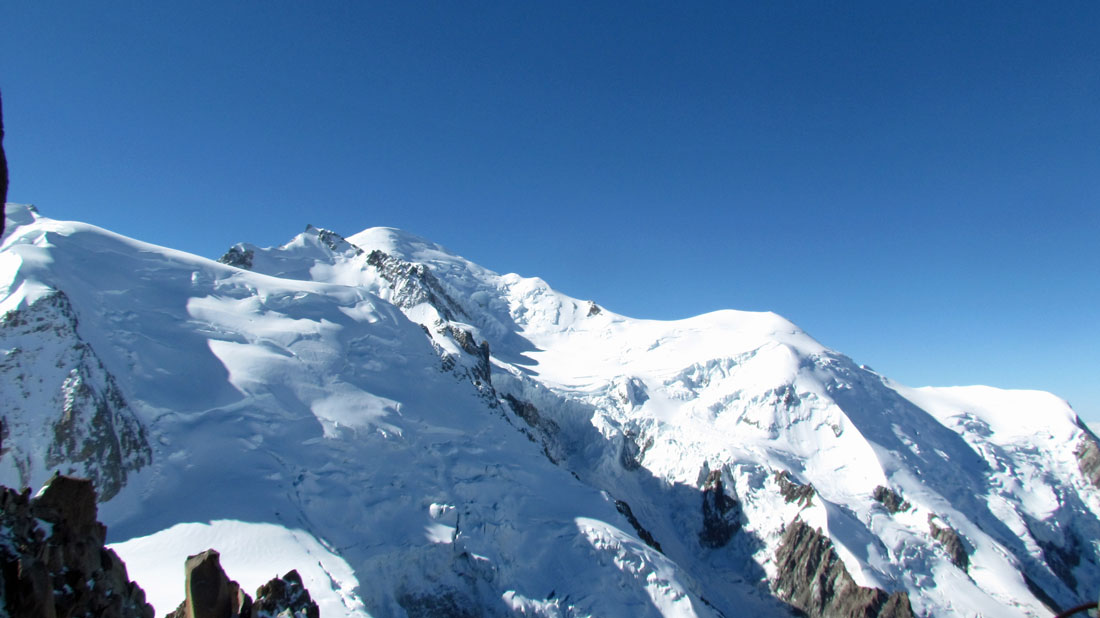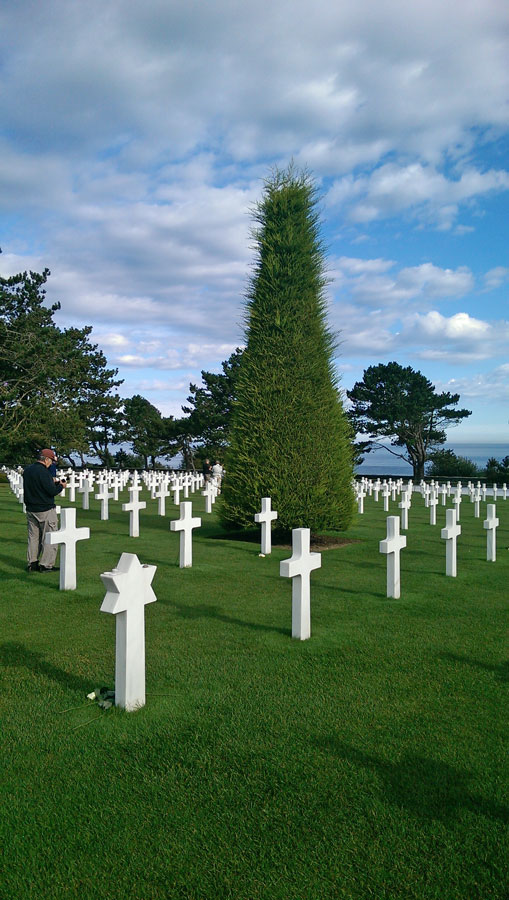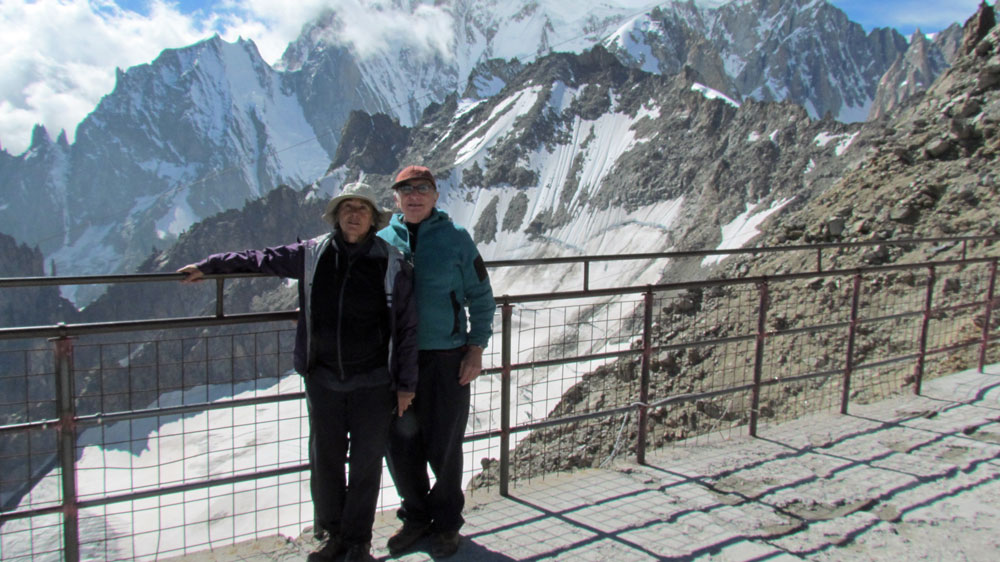Having visited Bhutan, Patagonia and Burkina Faso, we wanted a truly exotic destination. That’s how we ended up in France and England. The impetus was my wish to return to Chamonix. During my only previous time there, summer 1960, the weather had been uncooperative, dumping snow on almost all the peaks. The only summit we reached was the low, snow-free Aiguille de l’M. This time the weather was gorgeous, but we didn’t try to climb anything. Hiking was a different matter. Our first day we drove half an hour up the valley and set out for the refuge La Flégère. Refuges in the Alps often resemble rustic hotels. This one accommodates 90 and is “easily accessible by cable car.” But that’s only when the cable car is running. Many of them shut down after summer season--that is the end of August. It was September 10, but we would have hiked anyway. The trail ascends by a stream through a forest. After a few minutes you reach a waterfall and a restaurant. After close to another hour you pass the tree line into a wide, rocky valley. The way is moderately but persistently uphill. The trail is popular and easy to follow, except where it dips to avoid a recent landslide--perhaps the consequence of rising temperatures. The refuge itself looks like a prison block, but sells refreshments (including beer), which you can consume on the terrace. Such are the amenities of hiking in the Alps.
One of the téléphériques that still run in September is the most famous: to the Aiguille du Midi. It is spectacular and very popular, but to be avoided if you dislike heights. In two stages it lifts you more than 9000 feet. At one point it seems certain to crash into the rocks, but it won’t. You arrive at nearly 12,7000 feet. (In summer, you can continue over a shoulder of Mont Blanc and end up in Italy.) Bring your woollies. Hard snow glazed the wooden decks when we were there. There are of course a gift shop and restaurant. The 360-degree panorama is amazing. If you really want, you can visit the topmost tower, alarmingly called Le Pas dans le Vide.
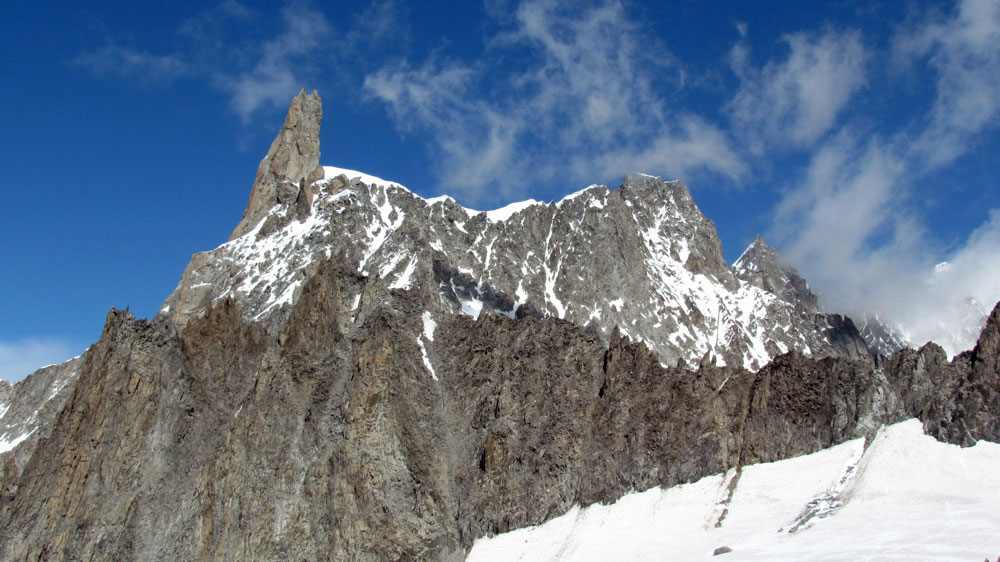
After admiring the view and shivering for 45 minutes, we téléphériqued down to the midpoint, the Plan de l’Aiguille. Thence we started on the nearly level trail to the venerable Montenvers Hotel, overlooking the vast but retreating glacier, the Mer de Glace. We passed by the M, on the route I had taken 54 years ago. To my distress, the terrain stopped being level: steep switchbacks to a wooded shoulder, followed by rocky terrain down to the hotel (closed for the season, but drinks still served). It was now late afternoon; we were happy to leave the trail for the 20-minute train ride 3000 feet down to Chamomix.
In addition to the téléphérique, you can get to Italy by driving around Mont Blanc or driving though it. The road tunnel is about 7 miles long, which made it the longest in the world when it was completed on 1965. Travel rules are strict: speed between 30 and about 42 miles per hour, with a 500-foot distance between vehicles. Vehicles are permitted entry with a minimum of seven seconds interval. Such caution is more than justified by the horrific fire of March 1999, which claimed some lives. You can read the grim story here
We emerged from the tunnel in another country, Italy, without any border check. We were now in Courmayeur, a quieter Chamonix. On this side, Mont Blanc is anything but the innocuous snow blob that you see from France. Instead there is the fearsome, rock-divided Brenva Face--read T. Graham Brown’s classic account in Brenva (1944). Even harder routes have been made on either side of the face. We had a great view of all this by taking a cable car to the Pavillon de Mont Fréty, ca. 7200 feet.
My accommodations in 1960 were age-appropriately modest. This time we stayed in a lovely small hotel in Les Praz, a 20-minute walk from town. It’s called vert et blanc and run by a British expatriate. Comfortable rooms with great views. Full breakfasts and also, when the chef comes in, dinners of high restaurant quality. We also had some good meals in town, one of them with our Canadian friend Joanne, whom we met in the Arctic three years ago.
When it was time to leave Chamonix, we drove our rented little Fiat back to Geneva. Whole books--adventure stories--could be written about renting cars at the Geneva airport. The crucial point is that the airport is in two countries, France and Switzerland. Because Chamonix is French, it seemed logical to rent on the French side. Long threads of internet info warned us, however, that this was very complicated. But renting in Switzerland would entail a road fee of $50 or more, just for a brief spell on Swiss highways. Reader, we rented in France. Yes it was complicated and probably not worth the $50 we had saved. The drive to Chamonix took more than twice the 70 minutes or so that it should have. Accordingly, we returned to Geneva a day early, just in case.... And it’s a good thing we did. We followed instructions to drive through the city, which seemed very quiet (it was Sunday). It took little time to realize that we were once again lost. We would occasionally spot an airport sign, but never a succession of them. Eventually Susan asked a security guard for assistance. He jumped in the car with us for a half mile to another airport sign. He refused any payment, even for a cab back to his work place. After a bit more confusion we pulled into the Hertz rental return and with great relief said farewell to the Fiat. But no. We were in the airport all right, but it was the Swiss side. To leave it there--“it’s another country”--would cost €250 (about $320). So our farewell had to be postponed for another frustrating half hour.
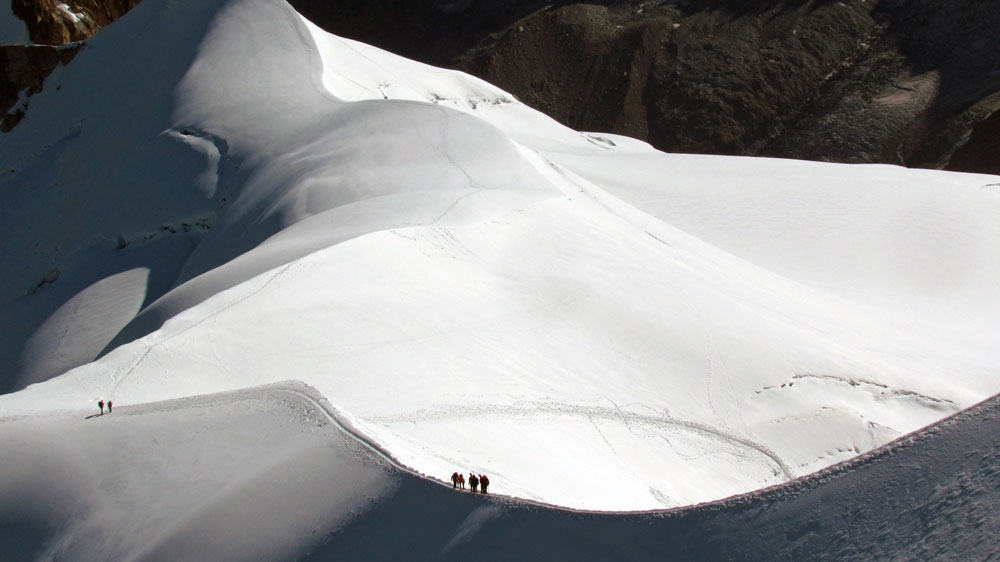
No more rental cars for us this trip, and no airplanes until we returned to New York. One virtue of our comfortable Geneva hotel, the Bernina, was that it was right across the street from the train station. The next morning we arrived in Paris after an on-time trip of three hours and 20 minutes.
This was our first visit in more than 10 years. This time we skipped the Louvre, the Eiffel Tower and the Pantheon, but went to the Pompidou (spacious and not very crowded) and the Arab Cultural Center, whichincludes a fine museum. Just as we were contemplating an expensive lunch there, we unexpectedly ran into our Brooklyn friends Paulette and Ira. We should not have felt surprised, as we had encountered them the same unforeseen way in Istanbul a few years back. We all had lunch, establishing a momentary Jewish presence of four in the building.
Much time was spent with American friends, starting with Kurt, my frequent climbing partner in the 1970’s. He has been a Paris resident for many years and , unlike us, is fluent in French. He was a great guide to many neighborhoods we would have missed. We also contacted Anna, the daughter of my Brooklyn College History colleague, David Troyansky. Anna had started a year of research for her doctoral degree in linguistics. Her subject involved French language acquisition of Arabic speakers. Kurt had also taken a degree in Arabic. So our last night we had dinner in a Moroccan restaurant: Kurt, his girlfriend who teaches Arabic; Kurt’s stepsister who lives in Spain but talks like a true New Yorker; Anna; and us.Very chummy. The food was good too.
We took a day off to visit some to the D-Day beaches in Normandy, which Susan had seen, but not I. A couple of train hours took us to Bayeux, where we spent the night in the very pleasant Hotel de Tardif. We arrived in time to check out the Bayeux tapestry. It is not what I had expected. It’s not a tapestry at all. It’s an embroidery only a couple feet high but nearly 200 long. It dramatizes the 1066 invasion of England from a distinctly Norman point of view.
The next day we joined 13 other tourists on a small bus to the two beaches where the Americans landed, Utah and Omaha. They are quite different. Utah is very wide
, backed by gentle vegetated slopes. Narrower Omaha leads to forbidding bluffs that provided the Germans deadly lines of fire. Thus casualties at Omaha were by far the higher of the two beaches. The nearby cemetery with thousands of crosses and a few Jewish stars testifies to the carnage. The beaches are quiet now and General Rommel’s ingenious murderous obstacles are gone, but still visible are the remains of German bunkers, where many defenders fired and died.
A word about our Paris accommodations: we had used Airbnb to rent a small flat in the Marais area. The neighborhood was fine, but the flat troublesome. Although its filmmaker owner was in Brazil, he had promised that his friend would meet us. This the friend was unable to do, but he left keys under the front door mat. Inside we found a pleasant airy space with a good kitchen. But there were some problems. We knew that the bed was in a sleeping loft, but we had not grasped now perilous was the access: a very steep ladder with raw rungs. Because the bathroom was down below, we had many scary descents. The loft itself had little light. We read by the head lamps we had fortunately brought. The kitchen included, as advertised, a clothes washer and a coffee make. We could not get either of these to work. The coffee maker looked like the cockpit of a small jet plane. At 9:45 p.m. the friend--a very affable young man--came to help out, but the coffee maker baffled even him. Eventually he got it to work by skyping the owner in Brazil for assistance. Note: the apartment had no written instructions for anything. We thought this a considerable lack. Another difficulty was the wi-fi code. In France they are typically 15 or more characters, which makes it easy to make a mistake.
Next stop: England. The rest of this account will be rather homey, because we were visiting old friends, one of whom I have known since his birth (1959) and another whom I met my first night at the university in Nigeria, exactly 50 years earlier.
First objective was Leicester, via the Chunnel train to London. The train speeds through the tunnel, but I wouldn’t know because I dozed off. It was a Sunday, a bad travel day in U. K. Two trains and a bus from St. Pancras to Leicester. There we stayed three nights with Mariette, her gay ex-husband Bob and her current straight husband Richard. It works out nicely. They rotate the cooking chores. We had three excellent home dinners. We also visited Mariette’s sister Tina, at whose London flat we had often stayed. She now lives in an airy Leicester home, with dozens of unopened cartons in the garage. The city’s most recent attraction is the skeleton, or parts thereof, of Richard III. Unfortunately by the time we reached them the bones had shut down for the night.
On to Liverpool to visit another friend from Nigeria: Margaret, who had taught with me in Calabar in 1977. This was a new city for us. Despite its reputation for grime, it is an attractive place, especially the waterfront. The museum had a big Mondrian exhibit. The main draw is the Beatles, who have a museum of their own. We had a look, but did not venture inside. We Shighly recommend the Spire restaurant, in Margaret’s neighborhood, Church Street (a block from Penny Lane).
A final train to our final stop, London. We had rented another Airbnb flat. Like the one in Paris, it provided no instructions or advice, but at least we met a human being--a young Bulgarian woman who was cleaning up after the last tenants. The flat was more straightforward than the Paris one, and had no ladders to negotiate. It was located in Fitzroy Street, about 25 minutes walk from the center of things. Sometimes we used the famous London Underground. Its fares have increased dramatically--from six pence in 1960 to $7.00 or more. You can pay less (though still a lot) by purchasing an oyster card. Using it is almost as complicated as driving to the Geneva airport (Susan diagrees). Take a look. One web site says, “The guidance that follows sounds horrendously complex, particularly for those who are not regular users of urban public transport systems. However, do not despair, it is really very simple and you will get the hang of it very quickly.” Maybe you will.
Like the Underground, London theater has become expensive, but it remains a bargain compared with Broadway. A great many offerings are imported musicals like The Lion King and The Book of Mormon. Also a production of David Mamet’s Speed-the-Plow, notable for the presence of Lindsay Lohan in the cast. These we skipped.
We saw:
1) Bring up the Bodies, from Hilary Mantel’s Tudor novel. Very long but very good. Coming to Broadway 2015 along with its predecessor, Wolf Hall.
2) An Enemy of the People. Ibsen as you have never seen him. At the very comfortable Barbican theatre. It was in German, with English titles. The characters were members of a band. Then in Act IV, at the climactic town meeting, the players broke into English and solicited comments from the audience--mostly about the dismal condition of the (British) country. We could not tell who in the audience was a plant, and who had a genuine grievance. Entertaining, in either case.
3) Great Britain. A very broad takeoff on the local hacking scandals of newspapers like Murdoch’s. Behavior perhaps too outlandish for satire.
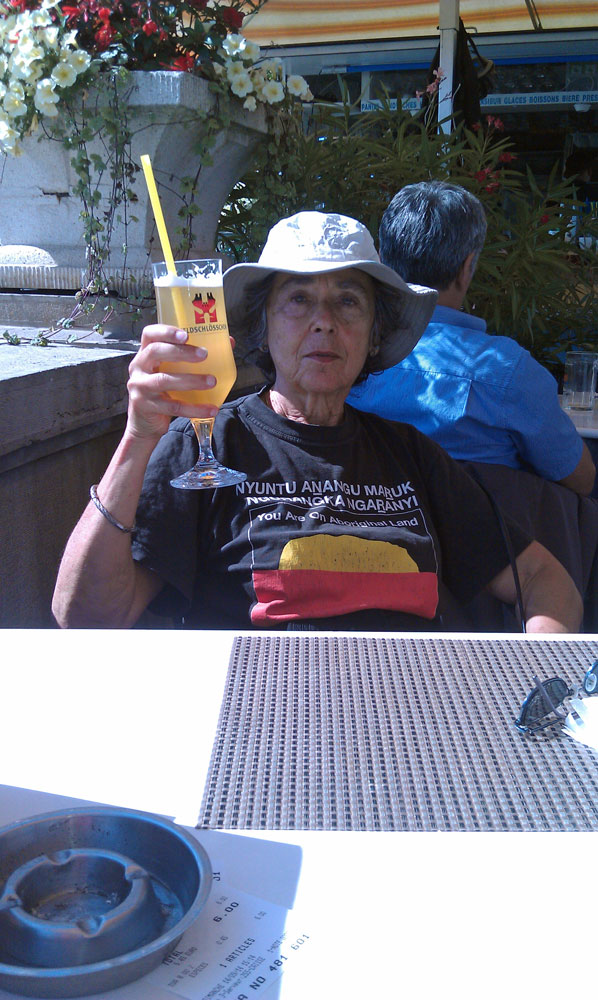
More reunions. Lunch with Marge, Richard, Kechi et. al...Brief explanation. Marge taught (math) with me in Nigeria. Although American, she has lived in London for years and is married to a Nigerian (Richard). They have a son (Keme) and daughter (Kechi). Some years ago at work Kechi met Bart, a young man. It took some time for them to realize that Bart’s parents, Mariette and Bob, taught with Marge in Nigeria. Kechi and Bart have a young son, Hal Obinna, who some day will know that three of his grandparents taught at Nsukka (U. of Nigeria) at the same time. In addition to Bart and Hal, Keme was there with his wife and two daughters. Got all this straight? Our other visit was with Jeff, son of my much-missed mountaineering partner, Craig Merrihue, who died in a climbing accident nearly 50 years ago. Jeff has spent much of his adult life in London. He has a grown daughter and step-daughter, and a 5-year-old son, Dylan Craig, whom we had not met. Jeff and his wife Maria have a stupendous penthouse with glorious views It is on Abbey Road (more Beatles). And Jeff is a great cook, as we discovered at dinner. He is known about town, too. He got us a coveted reservation at the Indian restaurant Gymkhana on Albermarle Street--along with a couple of free drinks. London food is fine although of course expensive. We prudently booked a month in advance for Ottolenghi (Upper Street).
We found time for other things than eating, watching plays and visiting friends. A walk along the Thames Path, which gives a view not only of the muddy water but also of new buildings know locally as the Pencil Sharpener and the Gherkin; the Tate Modern; the Jewish Museum; some of the very few remaining book shops on Charing Cross Road; a Virginia Woolf exhibit at the National Portrait Gallery; and a baot trip on the Regents Canal to Camden Town.
Our three weeks were now up. We had only to figure out how to get to Heathrow Airport. The least expensive way is to flourish your faithful oyster card and brave the crowds at the underground. With two big suitcases, we opted for a taxi. It was expensive, to be sure, but cost less than the more than $100 required to get us back from the Newark Airport that afternoon.
